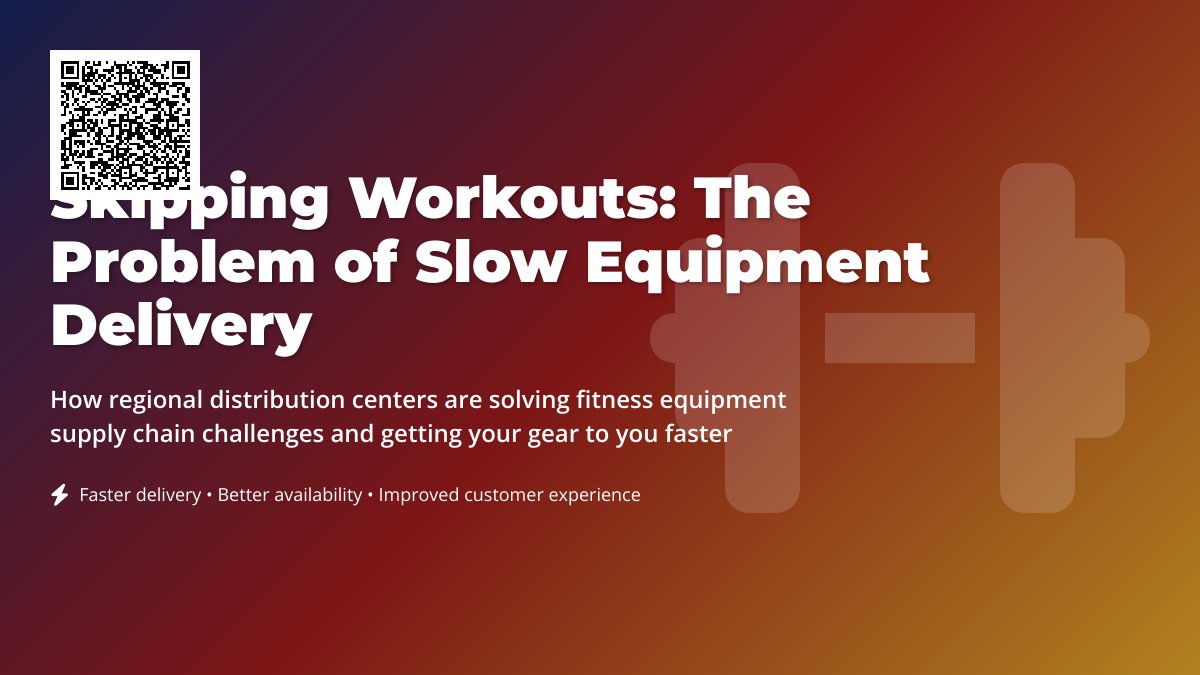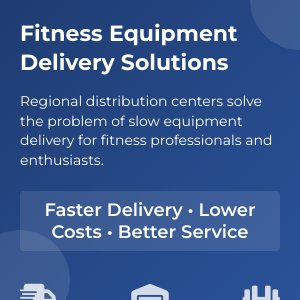Abstract: .
---
**Summary:**
The article explores the growing importance of regional distribution centers (RDCs) in the fitness equipment industry. Traditional supply chains have struggled to keep up with the recent surge in demand, resulting in long lead times, high shipping costs, and customer dissatisfaction. RDCs are changing the game by strategically locating inventory closer to consumers, enabling faster delivery, lower shipping costs, and improved inventory management. This shift benefits fitness enthusiasts by providing faster access to equipment, reducing shipping costs, and improving the overall customer experience. The rise of RDCs is also impacting the entire industry, fostering competition and driving innovation.

Skipping Workouts: The Problem of Slow Equipment Delivery
Fitness enthusiasts often face the frustrating reality of delayed equipment deliveries. Whether you're setting up a home gym or expanding a commercial facility, the wait time for essential gear can be disheartening. The traditional supply chain for fitness equipment is overburdened, leading to long delays that disrupt your training routine.
The Fitness Equipment Supply Chain Challenge
The fitness industry's rapid growth has created significant challenges in the supply chain. Here's a closer look at the issues:
- Global Manufacturer Dependency: Many fitness equipment manufacturers are based overseas, resulting in lengthy shipping times. Products often travel thousands of miles, facing potential delays at ports and customs.
- Inefficient Warehousing: Traditional logistics rely on centralized warehouses, which can be located far from the end user. This "one-size-fits-all" approach increases transit time and shipping costs.
- Inventory Management Struggles: Centralized systems struggle to meet regional demand, leading to stockouts or overstocking. This results in longer wait times and missed workout opportunities.
- Shipping Delays and Damages: Prolonged transit increases the risk of damage, causing further delays as items are sent back for replacement.
These challenges are particularly felt by fitness entrepreneurs and gym owners who need reliable equipment solutions to meet member demands.
The Solution: Regional Distribution Centers
Regional distribution centers (RDCs) are transforming the fitness equipment industry by bringing inventory closer to the end user. These strategically located facilities offer several advantages:
- Proximity to Customers: RDCs are situated in high-demand areas, enabling faster delivery times. This reduces the need for long-distance shipping and minimizes transit delays.
- Localized Inventory Management: Each RDC maintains a selection of popular equipment, ensuring better availability and reducing the likelihood of stockouts.
- Cost Efficiency: Shorter shipping distances lower costs, which can be passed on to consumers or reinvested in product quality.
- Improved Customer Service: Faster order fulfillment and better inventory management enhance the overall customer experience.
The Benefits for Fitness Enthusiasts
The shift to regional distribution centers brings multiple advantages:
- Faster Delivery: Equipment arrives when you need it, not weeks later.
- Convenience: Easy access to the gear you need supports consistent training.
- Cost Savings: Lower shipping costs allow you to invest more in your fitness journey.
- Greater Availability: Reduced frustration from out-of-stock items.
- Simplified Returns: Streamlined processes for returning unwanted products.
The Impact on the Fitness Industry
The rise of RDCs is reshaping the industry in several ways:
- Increased Competition: Smaller brands can now compete with larger players by offering faster delivery and lower costs.
- Innovative Product Development: Regional data provides insights for creating products tailored to specific preferences.
- Home Gym Growth: Convenient access to equipment fuels the home gym market, empowering individuals to prioritize their fitness.
- Sustainability: Reduced transportation distances contribute to a lower carbon footprint.
The Future of Fitness Equipment Distribution
The trend toward regional distribution centers is expected to continue, with potential developments including:
- Micro-Fulfillment Centers: Even smaller, urban facilities could emerge for ultra-fast delivery.
- Automation and Robotics: These technologies will enhance efficiency and reduce labor costs.
- Data-Driven Logistics: Advanced analytics will optimize inventory and delivery routes.
- Smart Integration: Fitness apps will connect with equipment retailers for personalized recommendations and automated reordering.
- Sustainable Practices: Adoption of electric vehicles and alternative fuels will further reduce environmental impact.
Conclusion: Embrace Regional Distribution Centers for Your Fitness Goals
As a fitness enthusiast, you deserve access to the equipment you need, when you need it. Regional distribution centers are addressing the long-standing challenges of the fitness equipment supply chain. By understanding the benefits of this innovative approach, you can ensure you're not missing out on workouts and can continue to pursue your fitness goals with greater ease and efficiency.
SEO Notes & Recommendations
- Keyword Density: Keywords like "fitness equipment," "regional distribution centers," "delivery," and "home gym" are naturally integrated throughout the article.
- Internal Linking: Link to other relevant articles about home gym setup, specific equipment types, or fitness tips.
- External Linking: Link to authoritative sources such as industry reports or logistics experts to build credibility.
- Image Optimization: Use descriptive alt text that includes relevant keywords. Compress images to improve page load speed.
- Meta Description: Create a compelling meta description that summarizes the article and includes relevant keywords.
- Header Tags: Ensure your H1 tag is clear and includes your primary keyword.
- Mobile-Friendliness: Ensure your website is responsive and looks good on all devices.
- Page Load Speed: Optimize your website for speed to avoid negative impacts on search rankings.
- Schema Markup: Consider adding schema markup to provide search engines with more information about your content.
- Target Audience: Tailor your language and content to resonate with fitness enthusiasts.
- Promote the Article: Share the article on social media, email newsletters, and other channels to drive traffic.
- Analyze and Adjust: Use analytics tools to track performance and make adjustments as needed.
To further tailor this article to your specific needs, please provide details about your target niche, audience, and key products.














